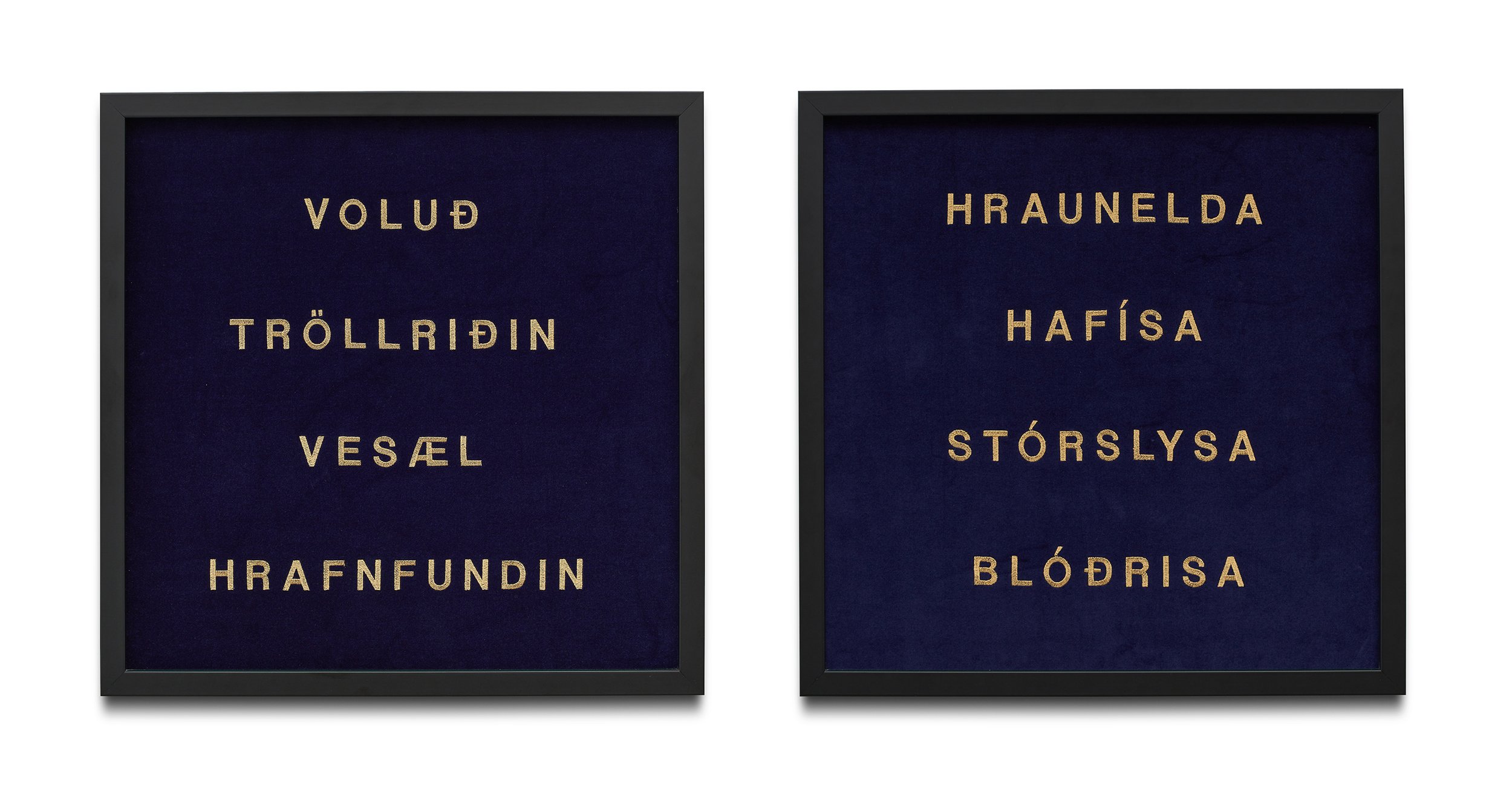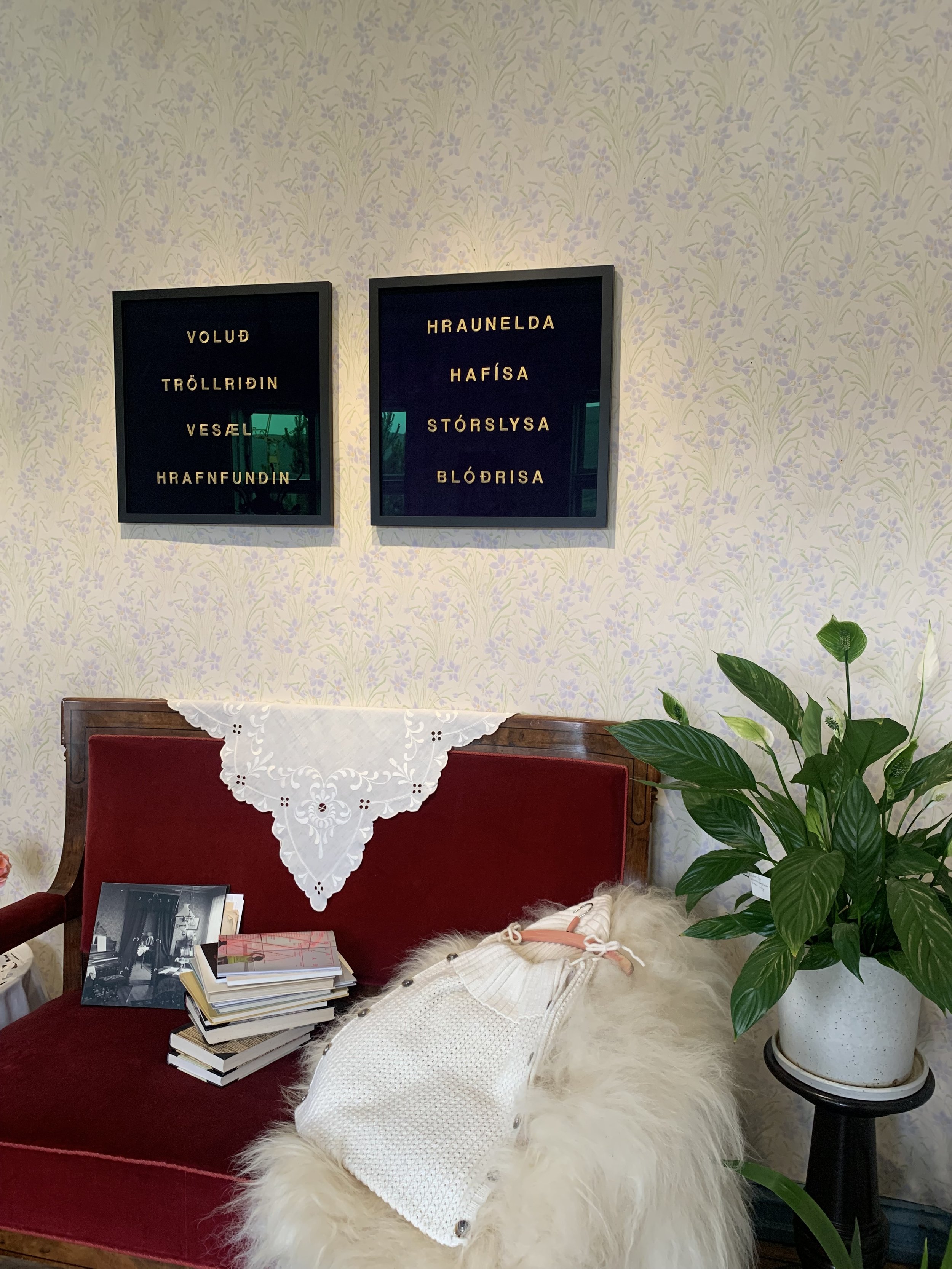Houses and Days
Text work and artist book, 2022
Paper, velvet, golden thread and cap
The exhibition Houses and Days is presented at the cultural center Sigurhæðir in Akureyri. The exhibition consisted of four textual works, artist book and cap. The artworks were specially made with the house and its history in mind. In parallel with the exhibition, I made artist book Roof / Faith that I dedicate to the memory of Jón Laxdal. The artist book is for sale in the antique bookstore Kanínuholunni.
Houses and Days
Time becomes a wall,
days become houses.
Houses become days.
Intrinsically, we have a need for tying our existence to a home. If everything is as it should be, if all is well, we have a home. Our time belongs to a house. We live every day within certain walls, otherwise we are not really living, merely scraping by. And most often we do not think of it, just take it for granted. Having a roof over one’s head is the prerequisite for being able to live and think, one which we also take for granted. However, we know that we must have a window (although we may not always celebrate the light) because otherwise we’d be in a cage. Thus, we do not really celebrate being surrounded by things that are taken for granted. We do not really celebrate the prerequisites for being able to live like we do.
That is why we should all turn our houses into museums.
Actually, we already do, whether we call it a home or the days passing. We connect every unit of time to the house. Every hour, every day, every weekend, every week, every month or year, number of years or even a decade; every period of time belongs to a certain building. We connect our lives, youth and old age, even a particular age number, to houses.
But only moments find their way to our walls. We document moments and instants and hang them up on our walls. A collection of memories, a selection of particular moments, printed out and framed. Snapshots, defined events, moments: Cairns on the paths of your life, similar from one home to another.
While the moments hang on the wall, the days gather into stacks, piles, creating a cairn of memories, not for a particular day but for time passing. Day by day by day. This passing, this endless being, is our existence.
That is why turning a home into a museum is special.
Making the home a memorial out of things belonging to those who have passed. Turning someone’s home into a memorial site for others, process their memories of existing within these walls, holding onto a house to remember a name. A name at the bottom of a page, beneath lines of poetry. A name on the spine of a book.
In what way are the walls of a house the prerequisite for living memories?
What can a roof, windows or the appearance of a house add to the memory of a man who wrote his name on a book or books, whose poems and lyrics echo in the minds of thousands?
How do you distinguish between a museum that is a memorial to a person in their former home and a mausoleum of memories of the same, without him?
Which brings on an even more important question: How to describe absence? How to display absence? How does one photograph absence? What colour is it?
I don’t have the answers. I only know how one experiences absence. All it is, is lack of presence. Absence is, simply put, the fact that someone isn’t there, isn’t around. The person is somewhere else, far away, not here. It is present in your mind but not in body. Death, yet life, but mostly impression post death. The presence has disappeared, it is gone. Over. This lack of presence, casually; just like forgetfulness it equals death.
And you experience absence the strongest in a particular house. Where a person is absent.
I expect houses are and will be a good way to remember Matthías and honour his memory. Same as with Davíð and Nonni. And Jón Laxdal.
---
Then, there is always another house, a particular house. Where you look out the windows every single day. This house has walls, panelling, rafters, roof, the lot. And has these windows we call eyes. A house, some kind of a museum. Not a mausoleum but a living museum.
In this house, all the poems live as long as the doors are open, before the temple crumbles.
---
Yes, we create electronic memorial volumes about the days that have passed, days gone, framed by an existence between walls, beneath a roof. Not unlike how we travel through our existence framed by a consciousness within our head. A memorial volume about hours, about the everyday, about having been, with or without a family, every day, living, making coffee, watching TV, and hopefully laughing a bit.
The memorial volume, if it’s not focusing on a particular time or moment, is passing. The summation of the percentage of 27375 days that an average person lives. The homes and houses people connect themselves to maintain this summation.
Time becomes wall, days become houses. Houses become days.






